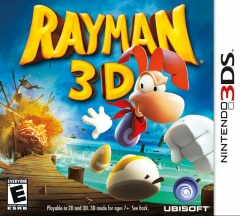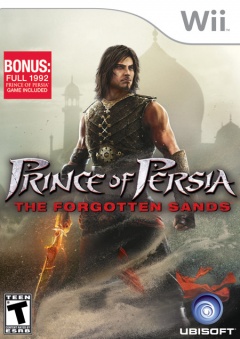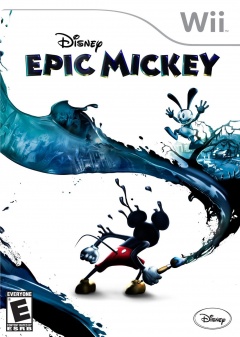ever-present assistant
Rayman 3D
 Platformers may be my favorite genre. Maybe I'm a product of the era I
grew up in, when so many developers tried to beat Super Mario Bros. at
its own game. Most failed, but that didn't stop me from enjoying the
multitude of games that celebrated the uncomplicated joy of running and
jumping skillfully across tricky terrain.
Platformers may be my favorite genre. Maybe I'm a product of the era I
grew up in, when so many developers tried to beat Super Mario Bros. at
its own game. Most failed, but that didn't stop me from enjoying the
multitude of games that celebrated the uncomplicated joy of running and
jumping skillfully across tricky terrain.
That said, the move from sprites to polygons did not treat the platformer kindly. So many of the colorful characters that were born in two dimensions were simply confounded by a third axis. I can only think of a handful of 3D platformers I've really enjoyed, and almost all of them begin with the words "Super Mario." To be fair, my standards are very high, and my definition of "platformer" is quite narrow as well.
And I've missed out on more than a few fondly-remembered 3D platformers, one of which is Rayman 2: The Great Escape. Originally released for the Nintendo 64 and Dreamcast, Rayman's first sequel (and first step into 3D) has become a cult classic of sorts. It's at least popular enough for Ubisoft to revive the game for the 3DS, just as it had seven years ago for the launch of the original Nintendo DS. Actually, according to Wikipedia, this game has been ported from the Nintendo 64 to Nintendo DS, Nintendo 3DS, PlayStation, PlayStation 2, Dreamcast, iPod Touch, and PC, in sum.
So how does Rayman 2 hold up after ten years and two ports to a picky platforming purist like me? And do the 3DS' stereoscopic visuals add a significant difference to the experience, as Nintendo claimed they could?
Prince of Persia: The Forgotten Sands
 Hollywood and video games have never had a healthy relationship. Ever
since the Super Mario Bros movie ruined millions of childhoods, video
game franchises of all kinds have received blasphemous silver screen
adaptations. The latest mainstream abuse of a video game license comes
from Prince of Persia: The Sands of Time. I'm not one to praise the
narrative of most games, but I really enjoyed the bittersweet fable of
the Prince and Farah that the 2002 hit presented. I've heard less
favorable things about the movie, and I don't think I want to see how it
ended up.
Hollywood and video games have never had a healthy relationship. Ever
since the Super Mario Bros movie ruined millions of childhoods, video
game franchises of all kinds have received blasphemous silver screen
adaptations. The latest mainstream abuse of a video game license comes
from Prince of Persia: The Sands of Time. I'm not one to praise the
narrative of most games, but I really enjoyed the bittersweet fable of
the Prince and Farah that the 2002 hit presented. I've heard less
favorable things about the movie, and I don't think I want to see how it
ended up.
The existence of Prince of Persia: The Forgotten Sands
is the result of one of the strangest cross-media cycles I've ever
seen. The Forgotten Sands, a sequel to the Sands of Time video game, was
released alongside the Sands of Time movie, an unrelated adaptation of
the Sands of Time video game. Even stranger, Sands of Time already
has a pair of sequels (Warrior Within, and The Two Thrones), but Forgotten Sands apparently precedes them. Even strangerer, the Wii
version of Forgotten Sands is actually an alternate tale to the version
of the game available for PS3, 360, and PC!
I'm still trying to
wrap my head around all that. The plotline of the Sands Trilogy was
already mind-bending enough with all the time travel going on, but now
Hollywood's gone and made everything worse! Oh well. I guess the more
pressing topic at hand is just how forgettable Forgotten Sands is on the
Wii.
Disney Epic Mickey
 Mickey Mouse was never a big part of my early life. I guess that's to be
expected: my grandfather remembers seeing Mickey Mouse cartoons when he
was young, and a kids' cartoon character can only stay relevant for so
long. I've never been into the whole corruption-of-childhood-icons
thing, either. It always sort of struck me as puerile and cheap, like
finding a genitalia-spacecraft dogfight penciled into the margins of a
social studies textbook.
Mickey Mouse was never a big part of my early life. I guess that's to be
expected: my grandfather remembers seeing Mickey Mouse cartoons when he
was young, and a kids' cartoon character can only stay relevant for so
long. I've never been into the whole corruption-of-childhood-icons
thing, either. It always sort of struck me as puerile and cheap, like
finding a genitalia-spacecraft dogfight penciled into the margins of a
social studies textbook.
So when I first saw the Game Informer
cover art for a dark take on Disney called Epic Mickey, I scoffed. I'd
never imagined such a thing would exist, and I couldn't fathom it being
worth a damn. I let out an unapproving sigh as I skimmed over the
concept art in the magazine, featuring mechanical perversions of classic
Disney characters. The designs themselves didn't bother me beyond their
tired post-apocalyptic, steampunk styles, but the concept itself seemed
like something a goth 7th grader might come up with after being dragged
to Disney World by his family.
As it turns out, all of that
imagery was just pre-production concept, used in the magazine to create
as much hype as the shock value could muster. The final product has a
safer appearance, one that most would say is more "tame." I think it's
just less gimmicky. Further details would catch my interest as well,
including the use of forgotten Disney properties to create an off-kilter
gameworld (rather than just a dark one) and the moral freedom system
that's supervised by a guy who excels at that sort of thing.
It's
been a strange hype cycle, but Epic Mickey has finally arrived. For the
first time, I'm actually anticipating a Mickey Mouse property. Is my
newfound interest warranted, or should I have left it in the trash with
that issue of Game Informer?
